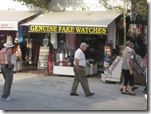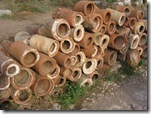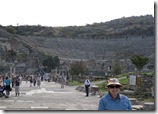You would think that a small town on the Adriatic coast of Turkey would be fairly free of tourists,  not when five cruise ships (two large, two small and one sailing) arrive on the same day. The reason for all this attention is the ancient town of Ephesus. Founded several hundred BCE, it sat on a river that was in almost a fjord, a very narrow ocean bay between two large mountains. It was a very perfect harbor, in this narrow gap between the mountains and protected from the weather. Unfortunately, over time, the river silted the harbor and the ocean moved further away. Today, it is about four miles from
not when five cruise ships (two large, two small and one sailing) arrive on the same day. The reason for all this attention is the ancient town of Ephesus. Founded several hundred BCE, it sat on a river that was in almost a fjord, a very narrow ocean bay between two large mountains. It was a very perfect harbor, in this narrow gap between the mountains and protected from the weather. Unfortunately, over time, the river silted the harbor and the ocean moved further away. Today, it is about four miles from the coast. The bus ride took about 25 minutes and dropped us off in an area of tourist shops (always). The shop keepers at least tell the truth some of the time. (See picture at right)
the coast. The bus ride took about 25 minutes and dropped us off in an area of tourist shops (always). The shop keepers at least tell the truth some of the time. (See picture at right)
Ephesus was a city of about a quarter of a million residents and spread over a wide area. Only about one half has been  excavated with work on excavation and restoration continuing. The roadways are clearly defined with houses and shops along both sides and paved with large blocks of marble. You can still see the places where the marble surfaces were marked with grooves to make it less slippery
excavated with work on excavation and restoration continuing. The roadways are clearly defined with houses and shops along both sides and paved with large blocks of marble. You can still see the places where the marble surfaces were marked with grooves to make it less slippery  when wet. As seems common in ancient excavations, there are always cats to make sure the tourists don’t abuse the site.
when wet. As seems common in ancient excavations, there are always cats to make sure the tourists don’t abuse the site.
The city had all the most modern conveniences available to a Roman city, it was, after all, the second largest city, trailing only Rome itself. All of the major houses had running water, the really fancy ones had both hot and cold. They also had a modern underground sewer system constructed of ceramic pipes. Even though they had indoor plumbing, apparently going to the communal toilet was an event like today’s going to the spa. Men
All of the major houses had running water, the really fancy ones had both hot and cold. They also had a modern underground sewer system constructed of ceramic pipes. Even though they had indoor plumbing, apparently going to the communal toilet was an event like today’s going to the spa. Men  sat around and discussed the news of the day, the latest politics and business. The Ephesus communal toilet had space for over 40 at a time. Some of them look
sat around and discussed the news of the day, the latest politics and business. The Ephesus communal toilet had space for over 40 at a time. Some of them look like they could have been found in a present day system.
like they could have been found in a present day system.
The highlight of Ephesus is the library built in Roman times. It was an elaborate two story structure build to contain a collection of over 12,000 scrolls.  Unfortunately, Cleopatra, who was visiting Ephesus with Marc Antony, moved the collection to Alexandria and they were destroyed in the great fire.
Unfortunately, Cleopatra, who was visiting Ephesus with Marc Antony, moved the collection to Alexandria and they were destroyed in the great fire.
Connecting the city to the port was a wide avenue bordered by marble columns. The other highlight of the city is the large theatre. There are two theatres in town, the small one seating a bit over 1,000 and the larger one almost 25,000. It was in the  larger one that Paul, of Christian fame was to address the people. He was chased out of town before his talk and so the New Testament has in it Paul’s Letter to the Ephesians, telling them the message he wasn’t allowed to deliver. Much of what is known about Ephesus during that period comes from that source. After the theatre, we left Ephesus and returned to Kusudasi for a little shopping and then back on to the ship. Istanbul is tomorrow, so more Turkey.
larger one that Paul, of Christian fame was to address the people. He was chased out of town before his talk and so the New Testament has in it Paul’s Letter to the Ephesians, telling them the message he wasn’t allowed to deliver. Much of what is known about Ephesus during that period comes from that source. After the theatre, we left Ephesus and returned to Kusudasi for a little shopping and then back on to the ship. Istanbul is tomorrow, so more Turkey.
No comments:
Post a Comment